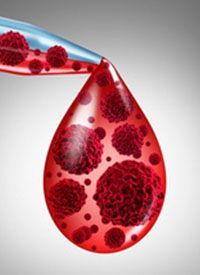Ruxolitinib Could Prevent Serious GVHD Following Allogeneic HCT
The use of ruxolitinib following an allogeneic hematopoietic cell transplantation was associated with the prevention of serious graft-versus-host disease.

The use of ruxolitinib (Jakafi) following an allogeneic hematopoietic cell transplantation (HCT) was associated with the prevention of serious graft-versus-host disease (GHVD), according to interim data from 2 ongoing phase 2 trials (NCT03286530 and NCT03427866) presented at the 2022 Tandem Meetings for Transplantation & Cellular Therapies.
Although recent advances have informed novel and effective approaches to combat GVHD, prevention warrants further investigation, as well as potential for JAK inhibition to prevent GVHD since it has not been well investigated.
These phase 2 studies evaluated ruxolitinib activity in patients with acute myeloid leukemia (AML; NCT03286530) and patients with myelofibrosis (MF; NCT03427866). At the time of analysis, the median follow-up among survivors is 18 months (range, 7-43). Between both patient populations, grade 2 acute GVHD appeared in 24% of patients (95%CI, 14%-36%) at 6 months, and no cases of grade 3 or 4 acute GVHD were observed. Chronic GVHD was observed in 21% of patients (95%CI, 11%-33%) with 3.8% (95%CI, 0.7%-12%) requiring systemic therapy.
The AML study included 33 patients who were diagnosed with AML, were between 60 and 80 years old, and had a human leukocyte antigen (HLA)-matched donor. Patients began ruxolitinib therapy 30 to 90 days post HCT and continued up to 24 cycles of 28 days continuously. The median start date for this patient population was day 47 (range, 32-93). The median number of cycles of ruxolitinib therapy received after HCT was 19 (range, 1-24). Twenty-six of the 33 are now of treatment. The primary end point was 1-year GVHD/relapse free survival rate. Secondary end points for this study were progression free survival (PFS), overall survival (OS), and time to relapse.2
The MF study included 21 patients who had an HLA-matched or mismatched donor. Ruxolitinib therapy started on day -14 and continued for up to 13 cycles of 28 days continuously after HCT. The median number of ruxolitinib treatment cycles post-HCT was 12 (range, 2-13). The primary end point was GVHD free and relapse free survival at 1 year. The secondary end points were PFS, OS, cumulative incidence of acute GVHD and chronic GVHD, and toxicity rate.3
For both studies at 18 months, the non-relapse mortality rate was 8% (95%CI, 2.5%-18%). The relapse rate was 24% (95%CI, 13%-37%), the OS was 79% (95%CI, 64%-88%), and the GVHD-free relapse-free survival was 67% (95%CI, 52%-78%).
The median age of patients was 67 years (range, 46-79. Investigators noted that 42 patients (78%) had HLA-matched unrelated donors, 11 (20%) had an HLA-matched sibling, and 1 (2%) had an HLA-mismatched unrelated donor. All patients observed had peripheral blood stem cell source, and all patients had reduced intensity conditioning.
The most common treatment-related grade 3 or higher adverse events observed so far are anemia in 10 patients, neutropenia in 5 patients, and thrombocytopenia in 5 patients.
Longer follow-up of these 2 trials will provide additional information on potential GVHD prevention, including JAK inhibition in the GVHD setting.
References
- DeFilipp, Z. Prolonged post-transplant ruxolitinib therapy is associated with protection from severe gvhd after Allogeneic HCT. Poster presented at the 2022 Tandem Meetings: Transplantation & Cellular Therapies Meetings; April 23-26, 2022; Salt Lake City, UT. Accessed April 24, 2022. https://tandem.confex.com/tandem/2022/meetingapp.cgi/Paper/19588
- Ruxolitinib + allogeneic stem cell transplantation in AML. ClinicalTrials.gov. Updated September 7, 2020. Accessed April 25, 2022. https://clinicaltrials.gov/ct2/show/record/NCT03286530
- Ruxolitinib pre-, during- and post-HSCT for patients with primary or secondary myelofibrosis. ClinicalTrials.gov. Updated September 7, 2020. Accessed April 25, 2022. https://clinicaltrials.gov/ct2/show/record/NCT03427866



